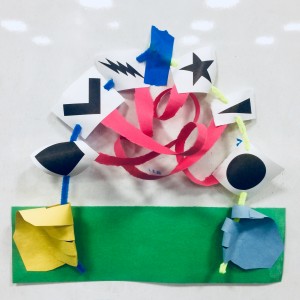Hello fellow Civic Media Co-Design Studio-mates!
My name is Akina (Aki) Younge and I am very excited to be in class with you all. As you know, the photo above is a representation of what I expect my design process to look like this semester. I expect my process to be collaborative, messy, connected, and colorful!
As someone who is coming into class without a community partner in mind, I am hoping to connect with someone who already has a developed relationship. So, for my design process, I put in paper hands holding different ends of the project string as a representation for me building relationships — with you, with the partner organization you already have, with other classmates, with people through the design process. Coming from coordinating legislative advocacy campaigns in New York City, I really value relationships because I think it allows everyone to feel like they are valuable and contributing. I can’t wait to share our expertise and discover what new expertise we have together.
I also expect my design process to be messy. This messiness comes from a belief that there is so much potential for connection and the best way to get at the connection is through trial and error, feedback, and curiosity. The pink curly paper represents the messiness and circuitousness that will come from our exploration. I think that I am a curious person: I love asking questions, defining purpose for a project, and reimagining what we could do. I have practiced some of those skills when I lived in Medellin, Colombia working for a group that conducted community visioning sessions with a neighborhood that was going to “revitalized.” A large part of the community visioning sessions was a map making project that helped us see connections about what people valued in their neighborhood: we would divide all attendees into small groups of 4, give them butcher paper and markers, and told them to draw their neighborhood. Each group would then report back, and we began to see themes about what people valued about their neighborhood from seeing what institutions, practices, places, people kept showing up on the maps from different groups. We then had people go back to their maps and draw what they wished were in their neighborhoods, helping highlight the expertise that the community had around designing where they lived and connecting people in the room who might be able to help create what someone had felt was missing. I am excited to learn more tools that can use my curiosity and desire to find connections as a way to co-design new solutions.
Because I feel very committed to grassroots, racial justice movements, I put a layer of green in my design process to represent the hands as being rooted in grassroots communities and organizing. I am Black and Japanese and have always connected my work into racial equity. As a policy student, I am focused on creating policies that further neighborhood and school integration and that intentionally use data and algorithms to further equity. I have seen that even when polices around neighborhoods, schools, and the use of data and algorithms are well intentioned, they often reinforce racism. I believe that the way we get out of this cycle of well-intentioned racist results is through intentional design that is rooted in a commitment to systemic change. That rootedness usually grows out amazing grassroot organizing groups, and so I hope my design process stays grounded in community and community organizing.
